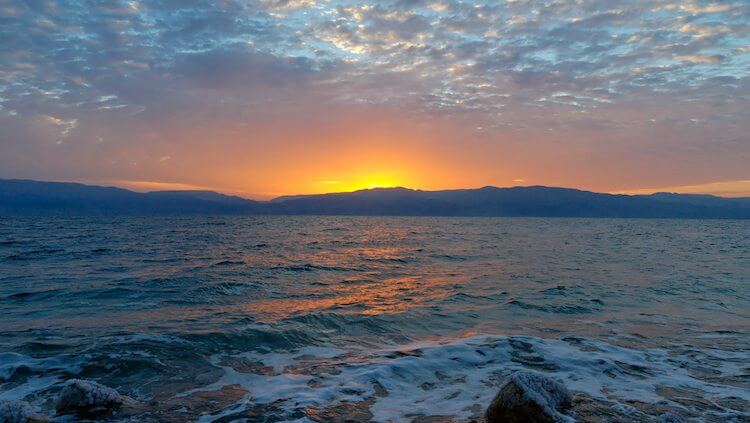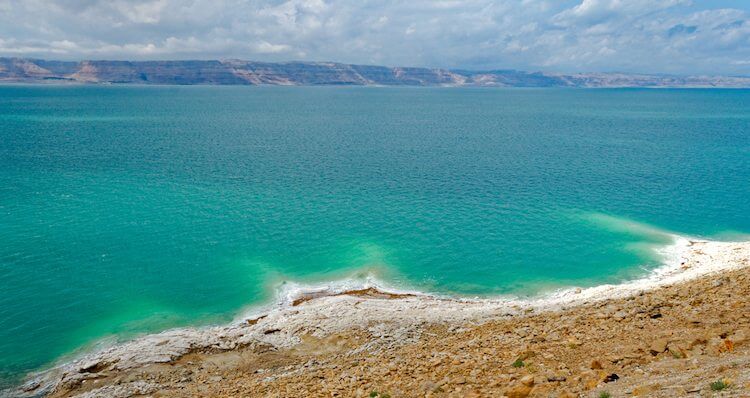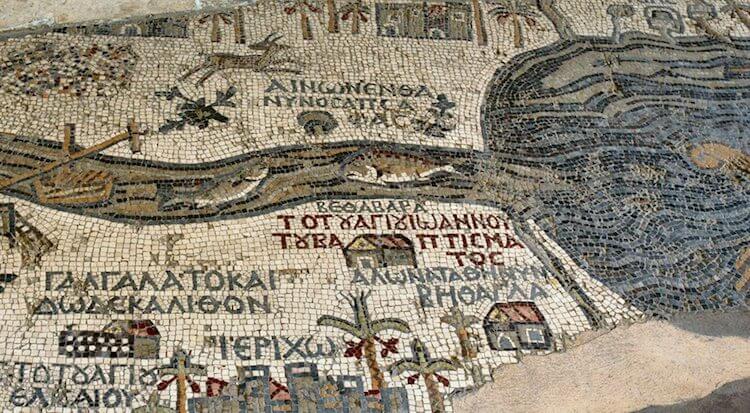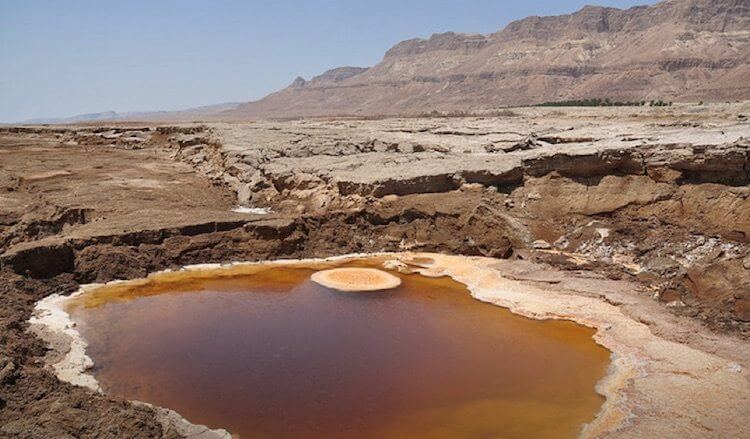Piles of driftwood, bleached white, surround the shoreline like bones from a life lived long-ago. It’s the lowest place on earth, the hottest spot in Israel, and nothing visible can live in its waters. The Dead Sea.

(Photo: Sunrise over Dead Sea. Courtesy of the Pictorial Library of Bible Lands)
With a name like the Dead Sea, this unusual site might lead you to expect a disappointing visit.
Rest assured—anyone who experiences the Dead Sea never forgets its wonder.
An Ancient Reputation—Unsinkable
The Dead Sea’s density has given it a reputation that people throughout history have found irresistible: you cannot sink.
- Josephus records that when Vespasian came to the Dead Sea during the Jewish Revolt in AD 68, he decided to test that unsinkable reputation by tying up some people who couldn’t swim and tossing them in the water! (Why tie them if they couldn’t swim?)
- The high salinity offers a good reminder to avoid water in the eyes and mouth—unless you enjoy weeping and vomiting. And its water in the lungs is fatal. (Who’d have thought?)

(Photo: Dead Sea shore with salt deposits. Courtesy of the Pictorial Library of Bible Lands)
Those commonsense warnings observed, the sea rewards each visitor with an unforgettable experience—including really oily skin and one-of-a-kind photographs. While tourists purchase special facial creams and hand lotions made from Dead Sea minerals, most people come to the sea to experience its remarkable buoyancy.
Wading into the brackish water, many swimmers scoop handfuls of black mud and slather it on their bodies before smiling for the camera. I’ll never forget the strange sensation I had the first time I experienced the Dead Sea’s dense salinity. I literally could stand still and upright without touching bottom and float with the surface of the water at my chest! Other tourists floated beside me on their backs, easily reading books. Thrown sticks rested on the surface as though lying on a mirror.
Even fish react to the salinity! A mosaic on the floor of a church in Medeba, Jordan, represents an early tourist map for Byzantine pilgrims on their way to the Holy Land. The map shows fish swimming down the Jordan River and then turning around once they hit the Dead Sea!

(Photo: Medeba map shows fish swimming up the Jordan River to avoid the Dead Sea. Courtesy of the Pictorial Library of Bible Lands)
Evaporation—The Dead Sea’s Curse
The Jordan River snakes down from the base of Mount Hermon and empties its flow just south of Jericho into the Dead Sea. Today, most of the Jordan River is diverted for domestic and agricultural interests. What continues to flow delivers the Dead Sea’s only continuous intake to replenish what water evaporates. And it isn’t enough.
With shrinking dimensions measuring thirty-one miles long by nine miles wide, the Dead Sea evaporates millions of tons of water each day.
- The diminishing water level poses a threat that the sea could eventually disappear altogether.
- The declining water level has also created dangerous sinkholes that make the ground unstable and unsafe for vehicles and hikers.
- Tourism suffers for bathers as the shoreline moves farther from hotels and changing facilities—and fewer inexpensive beach options remain open and available.

(Photo: Dead Sea sinkhole, courtesy of Shmuel Browns)
For years Israel and Jordan have debated possible solutions. But only recently have they agreed on a deal to pump brine from the Red Sea’s water purification plant 100 miles north to replenish the Dead Sea’s evaporation.
Evaporation—The Dead Sea’s Blessing
Although the evaporation causes one set of problems, it also provides a source of commerce. As the water evaporates, it leaves behind concentrated calcium, magnesium, potassium, and sodium chlorides, giving the Dead Sea the highest salinity of any body of water on earth and providing industrious humans throughout history with desirable products.
- The Nabataens in the fourth-century BC exemplify some of the many who have harvested the minerals for commercial purposes.
- Today, the Dead Sea’s minerals remain big business. The worldwide demand for products keeps more than 1,500 employees working around the clock.
Insight from the Dead Sea: Life from Death
The Dead Sea has had many names throughout history.
- Scripture refers to it as the “Salt Sea” (Numbers 34:3), the “Sea” (Ezekiel 47:8), and the “Eastern Sea” (Joel 2:20).
- Other designations in history include the “Sea of Asphalt,” the “Stinking Sea,” and the “Devil’s Sea.”
It’s hard to believe, but the region used to be a well-watered area—as lush and attractive as the Garden of Eden. But God’s judgment on Sodom and Gomorrah changed the area from a fertile land to a desolate expanse (Genesis 13:10; Deuteronomy 29:23; Jeremiah 17:6). The evaporation hovering over the Dead Sea yields a constant haze over its surface that reminds visitors of the furnace-like smoke that rose from the valley after the destruction of Sodom (Genesis 19:28).
But one day, Scripture promises, the Dead Sea will live again—and not because of the new plan to pump water north from the Red Sea.
When the Messiah Jesus rules the earth in the kingdom of God, water will flow from Jerusalem’s Temple Mount and fishermen will line the banks of the Dead Sea (Ezekiel 47:8–11; Zechariah 14:8). What a picture of God’s power to bring life from death!
I wonder what we’ll call the Dead Sea in that day?
Tell me what you think: In what ways has God brought life from death for you? To leave a comment, just click here.
Dead Sea on the Map:
Visit the Dead Sea and Other Biblical Sites
See the Bible lands in person! Learn more about upcoming trips:

